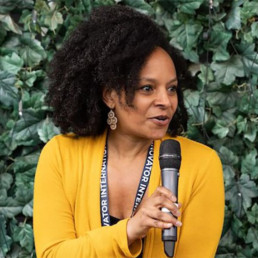Why Every Child Deserves to Hear Their Own Song

Written by Matthew Dix
Matthew Dix is a primary school teacher of 17 years. He continues to work as a teacher whilst working as a primary reading consultant across Nottinghamshire. He is the Founder of resource website Manic Street Teachers and has recently launched 'Musician of the Month' to create a culture of musical appreciation and understanding across schools, with a focus on diversity and inclusion.
Growing up, music wasn’t just background noise – it was how I made sense of the world. It was my mum playing the piano, it was watching her dance to ABBA and playing, of all things, a mandolin! It was my dad blasting heavy metal one minute and Vivaldi the next. Nothing quite says ‘peaceful Sunday morning’ like Iron Maiden shaking the windows!
As I reached adolescence, my heroes ranged from Tupac Shakur to Freddie Mercury, from John Lennon to Annie Lennox. Following their lives taught me that struggles were universal and at the end of a struggle, there can still be success. Behind every composition, every lyric, every guitar solo was a person with a story – often one of resilience against all odds.
Music took centre stage when I formed an indie band in the early 2000s. It wrote songs, often with the children’s help, for primary school subjects when I began my career as a teacher. It was a focus of mine when I created the music resources for ‘Manic Street Teachers’. Music has always been in the foreground of whatever I do.
A decade ago, I took a job in an inner-city school in Nottingham with 98% of children having English as an additional language. In fact, there were 52 different languages spoken in total. And yet, the music curriculum offered very few mirrors of themselves or windows to other worlds. A colleague and I decided to introduce a new musician every month in the hope of engaging children who seemed vacant during singing assemblies, and often unable to discuss and share their likes and dislikes in music lessons.
It wasn’t until we chose Nusrat Fateh Ali Khan as a musician one month that parents started to leave emails, children started to talk and a buzz started to make its way through school. I remember a child telling me that their parents listened to him at home. We shared his life, his trials and tribulations, his achievements and videos of his performances. Children could explain his words and what they meant. They were fascinated to learn that he had come to England in 1985 and brought Qawwali music (a form of Sufi Islamic devotional singing originating in India) with him. Children finally saw themselves and their families in our curriculum.
👉 Free Sample (Nusrat Fateh Ali Khan) – sign in required
It got us thinking. What if a girl thought that she could never be a classical musician because she looked nothing like Mozart, Beethoven or Bach? Well, we created resources all about Florence Price, whose compositions were forgotten until, just 16 years ago, when a whole collection of her work was rediscovered in a dilapidated house on the outskirts of St. Anne, Illinois.
What about a child who believes music is impossible with a disability? We shared Stevie Wonder’s story, Jacqueline du Pré’s story, and we shared how Joni Mitchell had to detune her guitar to learn to play another way after polio affected her hand. Let’s show them how these artists found ways to keep playing, no matter what. The show must go on, as Freddie Mercury said!
We live in a global world – our music curriculum should reflect that. Instead of saying, “Let’s learn African drumming,” let’s say, “Let’s learn about Babatunde Olatunji, a Nigerian drummer who learned by immersing himself in the culture and following the master drummers in his village, eventually being given a cowbell and then various Yoruba drums, took his craft to America, became an important friend to Martin Luther King Jr., and became a world-wide sensation!”
If a child thinks you can’t play music when you’re old, then share the story of The Buena Vista Social Club – how Ry Cooder, a producer from the US, had a twist of fate when musicians from Mali had their visas delayed so he ended up in Cuba, reuniting forgotten musicians like Ibrahim Ferrer, who was still shining shoes to make ends meet. The musicians, most of whom were over 70 years old, finally had a chance to tour the world with their music.
👉 Read our EYFS eBook (Ibrahim’s Song)
Context is always king, and every child loves a story. I believe the person behind the music is as important as the music itself, and becomes the bridge to another world. Teaching children to empathise helps them feel less detached from the music they are studying. Music bridges cultures, generations, and experiences in ways that words alone sometimes cannot.
That’s why I created Musician of the Month – a simple, accessible way for teachers to bring diverse musical stories into their classrooms. It’s directly linked to The Model Music Curriculum and the 9 Protected Characteristics and, as the site develops, we hope it will help schools show every child that they too can be a musician. To a child in school, the right musician, with the right song, at the right moment could well hit the right notes!
👉 Musician of the Month + Free Sample (David Bowie)
Using drama to drive empathy in schools

Written by Rachel Crowther
Rachel is a trained actor, coach and founder of Squash. She started working in L&D over 10 years ago and experimented with using drama to bring training to life. She created Squash to address some of the harmful workplace behaviours that were accepted as the status-quo and to offer an engaging antidote to traditional, tick-box DEI training. She’s designed and delivered impactful training experiences for global organisations, charities and young people.
Empathy is an important skill for young people (and adults) to develop. It helps them build relationships, resolve disagreements and create more inclusive environments – in the classroom and in the office. A powerful way to encourage empathy, is through drama..
I run corporate workshops for adults, using actors to spotlight behaviours and perspectives and to start meaningful conversations. Something our workshops enable, is for participants to step into someone else’s shoes.
A phrase we often hear in discussions is “We don’t know what we don’t know.” There is so much we don’t know about those around us, classmates and colleagues, the challenges and barriers they face. We often make assumptions and generalisations, to fill in the blanks, but this is where unconscious bias creeps in. Instead, learning the importance of curiosity and perspective-taking from a young age, prevents us making assumptions and helps us to create genuine, connections.
Storytelling and role-playing are simple ways for students to experience situations from multiple perspectives and are effective tools to start objective conversations on important topics like friendships, bullying, cultural differences. It builds an awareness of the unseen challenges faced by those around them, strengthening the muscle for empathy.
It’s a way for young people to experience feelings in a safe environment. For instance, acting out a scenario in which they are excluded from a playground activity. Feeling this kind of experience, in a safe, facilitated environment, is going to be far more impactful than just being told about it.
Empathy isn’t just about understanding someone else’s feelings – it’s also about how we respond. Drama helps young people to ‘rehearse’ difficult social situations. Practicing the ability to actively listen, express themselves clearly and respond with sensitivity. Improvisation is a great way to develop communications skills and the ability to think on their feet.
The benefits of developing empathy at a young age are clear. It helps young people to stand up for others and create inclusive, and welcoming school cultures and communities. Using drama is a way to not only understand empathy but to feel it and it’s that emotional connection that they’ll remember throughout their education and beyond.
True Inclusion Starts with Seeing Students for Who They Are

Written by Purvi Gandhi
Purvi Gandhi, MA MBA FCCT CPsychol is a psychologist, educator, and advocate for student wellbeing, leadership, and equity in education. With a career spanning clinical psychology, secondary and post-secondary education, and educational leadership, she bridges mental health and education through evidence-informed practice. She is the author of A Little Guide for Teachers: Student Mental Health, a practical resource for educators.
Imagine stepping into a new environment where your name is mispronounced or shortened to something more “convenient.” It’s a minor inconvenience, perhaps, but one that over time chips away at your sense of belonging. Now imagine this happening every day, in a place where you are supposed to grow, learn, and thrive.
For many students, particularly those from ethnic minority backgrounds, this is not hypothetical—it is their daily reality. And yet, within the walls of our classrooms, the power of a name is often underestimated. Names are not just labels; they carry history, identity, and cultural heritage. To overlook them is to overlook the student. To get them right is to affirm who they are.
Beyond Good Intentions: Why Inclusion Must Be Active
In a recent workshop with early career teachers, we explored what it really means to create inclusive classrooms—beyond policies, beyond slogans, and into the lived experiences of students. The session began with a simple but revealing exercise: storytelling.
One African tale set the tone. A great flood sweeps through the land, and every animal finds a way to escape—even the mighty crocodile. High up in the trees, the monkeys spot a fish struggling in the floodwaters. Moved by compassion, they “rescue” it, placing it safely on a branch. Of course, the fish begins to suffocate.
The lesson is clear: good intentions do not equate to good outcomes. In education, a one-size-fits-all approach can be just as ineffective as the monkeys’ well-meaning mistake. Every student has unique needs, shaped by culture, background, and identity. The question is, are we paying attention?
Consider this: A teacher, in an off-the-cuff remark during a classroom discussion on relationships, casually states that arranged marriages are “backward” or “unfair.” It’s not intended to harm, just a spontaneous reaction based on personal beliefs. But what if a student from a culture where arranged marriages are the norm is sitting there, quietly absorbing that statement?
Perhaps this student has spent years trying to navigate the space between two worlds—balancing the values of their family with the expectations of the society they are growing up in. Now, in a single moment, they are made to feel that their culture is lesser. They may go home carrying this conflict, questioning their parents, their upbringing, and where they truly belong. Suddenly, they feel like an outsider in both places—neither fully at home at school nor at home with their family.
This is the impact of uninformed assumptions. Educators do not just teach subjects; they shape perspectives. A thoughtless comment can widen the gap between a young person and their identity, making them feel alienated rather than empowered.
To be truly inclusive, we must move beyond our own perceptions and seek to understand the lived experiences of others. We must create spaces where students don’t feel forced to choose between their heritage and their education, but rather see their identities reflected and respected within the school environment.
Because, just like the fish in the flood, what a student truly needs may not be what we assume is best for them. Listening, learning, and adapting is the key to meaningful inclusion.
Rethinking What It Means to ‘See’ Our Students
An alternative version of the tale drove the point home. In this retelling, the animals hold a competition to see who can see the farthest. The eagle soars and surveys the horizon, the giraffe gazes across the savanna, and the monkey takes in the view from the treetops. When it’s the fish’s turn, it can only see the immediate waters around it. The other animals laugh—until the fish explains that while they focus on the distance, it detects subtle currents, hidden dangers, and movements they cannot perceive.
Here lies a second lesson: students should not be judged against a singular definition of success. The education system, often fixated on rigid measures of ability, risks missing the unique strengths that lie beneath the surface. A student who struggles with traditional assessments may have an extraordinary ability to lead, innovate, or empathize—if only we are willing to recognize it.
The Power of a Name
Of all the discussions that day, one stood out: the impact of names. Inspired by Bennie Kara’s work on diversity in education, we asked teachers to explore their own names—their meanings, origins, and the personal stories behind them. What followed was a conversation about identity, belonging, and the small but significant ways that schools can either affirm or erode a student’s sense of self.
One student shared how her intended name was “Yah Yah,” meaning “gift from God,” but her parents, wanting to make life easier in an English-speaking country, renamed her Ysabella. She was seated alongside another student, Anjali, whose name means “gift to God.” Here were two students, from different cultures, bound by the same idea: they were gifts.
Imagine the impact of recognising that connection—not as a coincidence, but as an intentional act of inclusion. When we take the time to pronounce a name correctly, to understand its meaning, or even to ask about it, we are sending a powerful message: You belong here.
Moving From Awareness to Action
It is easy to talk about inclusion in broad terms. It is harder—but far more necessary—to embed it into daily teaching practice. The workshop concluded with three core reflections for teachers:
- Cultural Competence: How much do I really know about my students’ backgrounds? Where are the gaps? What steps can I take to learn more?
- Equity Over Equality: Do I recognize the unique needs of my students? How can I tailor my support to meet them where they are?
- Celebrating Identity: What cultural capital do my students bring into the classroom? How can I acknowledge and honour it?
Education is not just about imparting knowledge; it is about shaping identities. A student who feels unseen will struggle to engage. A student who feels valued will thrive.
The work of inclusion is not grandiose. It does not require a total overhaul of curriculum or sweeping policy changes. It starts with the smallest of acts: a correctly pronounced name, a thoughtful seating plan, a recognition that success looks different for everyone.
And perhaps, that is the greatest takeaway of all—belonging is built in the details.
References:
Fernando-Smith,L and Aow, A, (2024), ‘Letting go of imposter syndrome: writing herstory.’ In Disruptive Women – A Guide for Equitable Action in Education, Corwin
Kara, B., 2020. A little guide for teachers: Diversity in schools, Corwin
Pierson, R., 2013. Every kid needs a champion. TED Talks Education.
You can’t just teach a child out of poverty

Written by Sean Harris and Katrina Morley
Sean Harris – Co-author and Director of PLACE (People, Learning and Community Engagement) at Tees Valley Education. Katrina Morley OBE – Co-author and CEO of Tees Valley Education.
One of the most urgent and complex issues schools face today is the deep-rooted impact of poverty on the communities they serve. For school leaders and educators, this isn’t just about data, it’s about real lives, and the daily reality of hardship affecting pupils and families.
The challenges of poverty extend well beyond the school gates. It influences everything from children’s learning experiences to their long-term life chances, often reinforcing cycles of inequality that are difficult to break.
But poverty and inequality do not have to be an inevitable part of the story we write in schools and communities.
Practice to Page
In Tackling Poverty and Disadvantage in Schools, we set out to create more than just another education book.
This is a collaborative guide, designed to support busy educators and stretched school leaders with practical tools and real-world strategies to help dismantle the complexity of inequality.
It reflects the voices of those working at the frontline, educators, leaders, and organisations who know what it means to walk within communities facing adversity.
This book is built on shared experience. It’s by the sector, for the sector, and with the sector.
It also challenges the rhetoric that the only or best way to tackle inequality is through excellent teaching alone.
‘While research consistently highlights the importance of high-quality teaching, policy and practice too often lean on this narrative to imply that a great teacher alone can overcome deep-rooted inequality. In reality, the schools making meaningful strides in addressing disadvantage recognise that delivering education in their communities requires a far more nuanced and holistic approach.’
Sean Harris: co-author
Director of PLACE (People, Learning and Community Engagement) at Tees Valley Education
No egos, no silos
What makes this project distinct is its collective approach. We brought together perspectives from across the UK and beyond: educators, researchers, policymakers, and thought leaders who are tackling educational inequality every day.
Each contributor brings school-based insight, evidence-informed thinking, and grounded practices. From making classrooms more inclusive and curriculum more equitable, to fostering a culture of social justice across whole-school systems, the book is packed with adaptable and proven strategies.
‘Schools alone are not the solution to tackling inequality, but they are an essential part of it. That’s why it was vital for this book to be shaped by the expertise and lived experiences of schools and organisations that are actively driving change. True progress comes through collaboration. Only by working together can we begin to understand and address the complex, enduring nature of disadvantage.’
Katrina Morley OBE
Co-author and CEO of Tees Valley Education
And let us be clear: while schools play a vital role in addressing disadvantage, they cannot do it alone. Education is only one component part of system change.
Optimism included
This book arrives at a critical moment.
Schools are contending with the lingering effects of COVID-19, the rising cost of living, and increasing poverty-related barriers to learning. We wanted to offer something constructive: a resource that doesn’t just highlight the issues, but offers a roadmap for making a difference.
The book has been written with busy leaders and educators in mind. We wanted to help educators foster environments where every child feels seen, supported, and capable of thriving, no matter their background.
Using the book
We know there’s no one-size-fits-all solution. Schools are diverse, complex places where staff face many competing demands. That’s why we designed this book to be both accessible and flexible.
The content is organised around three core themes:
- Whole-school approaches (e.g. leadership and school culture)
- Classroom practices (e.g. including teaching methods and curriculum design)
- Wider interventions (e.g. mentoring, family support, and industry partnerships)
These strands provide different entry points, depending on where your school is in its journey. Whether you’re a new or established teacher looking for classroom ideas or a senior leader seeking systemic change, we hope this book meets you where you are.
Each chapter follows a consistent and easy-to-navigate format:
Research Recap: We summarise key studies and evidence that help contextualise the topic. It’s rigorous but digestible, with signposts for further reading if you want to go deeper.
Case Studies: Real examples from schools and organisations that have put theory into action. These are not silver-bullets but grounded insights from practitioners who’ve tested and refined their approaches.
Reflection: Tools and activities for applying the ideas in your own setting. These can be used individually or with your team. Plus, we’ve included access to an online hub with templates, planning guides, and reflection exercises to keep the work going beyond the page.
Each chapter also ends with concise takeaway points—perfect for sharing over a quick chat with a colleague (caffeine optional, but encouraged!).
Professional generosity
What truly sets this project apart is the generosity and dedication of our contributors. Everyone involved has donated their time and waived royalties. Profits from the book will go directly to supporting initiatives that benefit children and young people living in poverty, through our work with Tees Valley Education.
This spirit of collaboration and shared purpose is at the heart of everything we’ve created here.
We didn’t want to produce another title that simply restates how hard things are or overcomplicates the problem. Instead, we focused on creating a useful, empowering, and hopeful resource for professionals in education.
Importantly, we’ve also been careful to approach the topic with dignity and respect. Children and young people facing poverty are not “problems” to be fixed. The real challenge lies in the systems and structures that make life harder for them. It’s those systems we must work to change—and we believe schools can be powerful agents in that process.
We hope Tackling Poverty and Disadvantage in Schools contributes something meaningful to the ongoing conversation about equity and education. Our thanks go to every school, leader, and educator who continues to show up, innovate, and stand with their communities.
World Book Day 2025

Written by Robert Davies
Rob Davies is Associate Assistant Headteacher at Calderstones School in Liverpool. This role involves leading on anti-racism in education, sharing practical strategies, reflections, and initiatives to create a more inclusive, representative, and equitable school. He shares insights on decolonising the curriculum, diversifying reading materials, and fostering anti-racist practices in schools.
Another year, another World Book Day—same costumes, same characters. Harry and Hermione? Check. Little Red Riding Hood? Of course. The Gruffalo? Naturally. And let’s not forget Mrs. Trunchbull, stomping through the halls. Sound familiar? Thought so.
But here’s the thing—World Book Day can be so much more. It’s time to move beyond the usual suspects and reimagine it through a truly diverse lens. Let’s make it an event where every student sees themselves in the stories we celebrate.
Every year, World Book Day celebrates the magic of stories. But whose stories are we telling? Who do they inspire? When books and characters overwhelmingly reflect white, middle-class experiences, whose voices are missing? Are we selecting a diverse range of books that offer all children equitable opportunities to see themselves?
If not, isn’t it just Book Day?
At its core, World Book Day aims to “promote reading for pleasure, offering every child and young person the opportunity to have a book of their own.” But if we fail to approach it through an anti-racist lens, are we truly serving all students?
The Representation Gap in Children’s Books
In the UK, 33.5% of school-aged children come from ethnic minority backgrounds. Yet, between 2017 and 2019, only 7% of children’s books featured characters from these cultures—and just 5% had a Black, Asian, or Minority Ethnic main character.
Research shows that when children see themselves in books, it shapes their sense of identity and possibility.
Despite limited representation, excellent books exist that help students feel seen, foster belonging, and cultivate a love of reading. But do schools actively seek them out?
The issue goes beyond just introducing diverse books. What if teachers haven’t read them, or don’t understand their significance?
Whose culture has capital?
With a predominantly white teaching workforce (Runnymede Trust, 2020), how often is World Book Day shaped through an anti-racist lens? One of the biggest motivators for reading is emotion—how books make us feel (Dungworth et al., 2004). Naturally, educators promote books that resonated with them in childhood, shaped by their own experiences.
If most books being championed reflect the same narrow cultural perspectives, what message does that send? Who do these books inspire—and who gets left out?
Research further supports this. More children from ethnic minority backgrounds than white backgrounds say they don’t see themselves in what they read (40% vs. 30.5%), with Black students feeling this most acutely.
Making It a World Book Day
If World Book Day is to truly reflect all students, schools must take active steps to make it more inclusive. That’s exactly what we did at Calderstones School this year.
As one of Liverpool’s largest secondary comprehensive schools, diversity is our strength. But we recognised that World Book Day needed to reflect that diversity, ensuring all students felt represented and engaged.
So, we embraced the ‘world’ in World Book Day. We focused on books and authors from a variety of cultures and languages, fostering conversations about students’ mother tongues and cultural backgrounds.
We collaborated with Greenbank Primary School and Leeds Beckett University to involve primary school students and Global Ambassadors. Together, they read books from their home countries in their native languages—including Arabic, Basque, Farsi, French, Greek, Mandarin, Polish, Russian, Urdu, and more.
By showcasing this linguistic and cultural diversity, we highlighted the vital importance of representation in education. The readings were recorded, edited, and shared on the school’s social media. The response? Overwhelmingly positive. For many in our community, this was the first time their language and heritage were visibly celebrated in school.
How to Rethink World Book Day in Your School
If we are serious about delivering a truly inclusive World Book Day, here’s lets start with the following: 1. Move Beyond the Same Old Costumes
Rather than dressing up as characters from GCSE texts, consider why these books dominate the curriculum. Less than 1% of GCSE students study a book by a writer of colour—so why reproduce that marginalisation on World Book Day?
- Conduct a Student Voice
Ask students:
- What books would you love to explore?
- Do you see your culture and heritage reflected in the school library?
- What stories are missing from the shelves?
- Use these insights to shape book selections and discussions.
- Explore Translated Literature
Many beloved English books originated in other languages—Pinocchio was originally Italian. What other global stories could students discover? World Book Day can be an opportunity to highlight the rich traditions of storytelling from around the world.
Final Thought: A Call to Action
By embracing the ‘world’ in World Book Day, we made it more meaningful for our students. This is a step in the right direction—but it can’t stop here. Schools must challenge traditional reading lists, elevate diverse voices, and ensure that every child sees themselves in the stories they read.
We can’t diversify the teaching workforce overnight, but we can broaden our thinking. We must ensure that we view events like World Book Day through an anti-racist lens.
Because if World Book Day doesn’t include all stories, is it really World Book Day at all?
Diversifying English Literature texts: Five ways to get your schools to invest

Written by Jessica Tacon
Jessica Tacon is second in charge of the English Department at City of London Academy Highgate Hill and is a member of NATE’s (National Association for the Teaching of English) ‘Reviewing Literature’ working group. She created The Right Writing campaign which aims to improve racial diversity in English Education.
The title of this piece reflects an ongoing challenge in education, but also an opportunity. While many schools and educators have made strides in diversifying their English curricula, there’s always room for progress. Students across the country deserve to see themselves reflected in the texts they study, while also being exposed to a wide range of perspectives. Diverse literature enriches learning experiences, fosters empathy, and ensures every student feels valued.
Here’s a brief overview of why a diverse and inclusive curriculum is essential:
- Representation matters: Research by Penguin Random House revealed that many students never study a text by a writer of colour, apart from a few poems in their GCSE studies. They also found that only 7% of students study a text by a woman, and just 0.1% study a text by a woman of colour. Every child deserves to see their experiences and identities reflected in what they read. Not only does this enhance engagement and enjoyment, but it can also lead to better academic outcomes.
- Retention in English Studies: When students don’t see themselves or diverse perspectives in their English lessons, they may perceive the subject as irrelevant. This may lead to a drop in the number of students pursuing English at A-level, which in turn impacts representation in higher education and English-related fields. A diverse curriculum can break this cycle by making the subject more relatable and meaningful.
- Broadening horizons: While representation is crucial, it’s equally important to introduce students to experiences, cultures, and voices beyond their own. Literature has always been a bridge to other worlds, offering insights into lives that differ from our own. This is a fundamental aspect of fostering curiosity and empathy in young people.
- Addressing historical imbalances: Historically, the English curriculum has often overlooked diverse voices. As educators, we have the opportunity (and responsibility) to address these imbalances and create and embed a curriculum that is inclusive, honest, and representative of a wide range of experiences.
Despite these clear benefits, the teaching of a diverse and inclusive range of literature texts isn’t yet the norm in all schools.
Support (and essential investment) is needed from senior leads in schools, and multi-academy trusts, to make this a reality. It is challenging as individuals may not be English specialists, but the points above highlight how a change in English can have a far-reaching impact on young people.
With this in mind, I would like to explore the common barriers to change and five solution-focused strategies to help schools embrace a more inclusive curriculum.
Strategies
Strategy 1: Emphasise the positive impact on students
Barrier: Leadership may focus on the potential challenges rather than the benefits of inclusivity.
Solution: Highlight the research-backed benefits of a diverse curriculum. For instance, the research by Penguin Random House shows students are more engaged when they see themselves reflected in their studies, and they perform better academically. Explain how inclusive texts also broaden students’ horizons, fostering empathy and critical thinking by exposing them to new perspectives and cultures. Frame change as being much less of a risk than continuing to teach a set of texts which actually may be disengaging students in the English classroom.
Message for leadership: A diverse curriculum creates a more engaged and motivated student body, which translates to higher achievement and a stronger school culture.
Strategy 2: Frame diversity as a shared responsibility
Barrier: Leaders may feel diversity initiatives are an additional challenge in an already complex system.
Solution: Present inclusivity as a professional and moral responsibility to address historical imbalances in education. Position the school as a leader in creating a curriculum that prepares students for life in a diverse and interconnected world.
Message for leadership: Diversity isn’t just a ‘nice-to-have’; it’s essential for fostering a fair and well-rounded education. Implementing an inclusive curriculum aligns with the school’s duty to provide all students with an equitable experience.
Strategy 3: Offer practical solutions to time and workload challenges
Barrier: Leaders may worry that introducing new texts will increase workload for already overstretched staff.
Solution: Reassure them that high-quality, ready-to-use resources are available. Platforms like BBC Bitesize offer support materials on a range of texts including some recently added to diversify exam board text options, such as My Name is Leon and Leave Taking. BBC Bitesize, as its name suggests, is a great jump-off point for exploring a diverse range of texts by breaking them down into manageable chunks.
Message for leadership: Implementing an inclusive curriculum doesn’t need to add extra strain. Leverage existing resources and expert support to streamline the process.
Strategy 4: Address staff confidence with professional development
Barrier: Some educators may feel unprepared to teach unfamiliar texts or discuss sensitive topics.
Solution: Advocate for investment in professional development such as training sessions or workshops that help staff gain confidence in teaching diverse texts. Highlight that introducing new material can be professionally invigorating, offering opportunities for growth and fresh perspectives. For instance, one text added to AQA’s English Literature GCSE as part of their diversity drive is Princess and the Hustler by Chinonyerem Odimba. It’s a modern, engaging text that explores rich themes, literary techniques, and historical context, making it a rewarding teaching (and learning) experience.
Message for leadership: Building staff confidence through professional development ensures successful implementation while reinvigorating teaching practices.
Strategy 5: Present change as achievable and incremental
Barrier: Leaders may see curriculum reform as an overwhelming, all-or-nothing process.
Solution: If this is the case, advocate for a phased approach, starting with small but meaningful changes (such as introducing one or two new texts). You could suggest piloting new texts with specific classes before scaling up.
Message for leadership: Curriculum change doesn’t need to happen all at once. An incremental approach makes the process manageable while demonstrating the positive impact of inclusive texts.
Looking ahead
It’s important to acknowledge that change in education is rarely quick or easy. However, the potential benefits far outweigh the challenges. A truly diverse and inclusive curriculum not only enriches students’ academic experiences but also prepares them to navigate an increasingly interconnected world.
Of course, diversifying texts is just one part of creating an inclusive school environment. Staff training, teaching approaches, and the broader school culture all play critical roles in ensuring that diversity is embedded meaningfully and authentically.
Every student deserves an education that values their identity and broadens their horizons. As we move forward, let’s commit to making this vision a reality.
To access the BBC Bitesize GCSE English Literature collection, please visit: https://rebrand.ly/7d51da
Building Self-Esteem in the Classroom: A New Premier League Primary Stars Resource

Written by PLPS
Premier League Primary Stars helps children to learn through the power of football in more than 19,000 primary schools across England and Wales. Free Premier League Primary Stars resources can be downloaded from www.plprimarystars.com
Supporting children’s mental health and well-being has never been more important. Schools play a pivotal role in nurturing confident, inclusive, and resilient pupils, and teachers need the right tools to make this happen. That’s why Premier League Primary Stars is excited to introduce their latest free teaching resource: Building Self-Esteem.
Developed with input from PSHE experts and teachers, the Building Self-Esteem pack offers teachers an engaging way to help pupils reflect on their identity, celebrate their strengths, and build positive attitudes that foster personal growth. It’s an ideal tool to use in preparation for Children’s Mental Health Week (3-9 February), but its impact goes far beyond a single week – this resource can be used year-round to promote lasting self-worth and inclusivity in the classroom.
Why Self-Esteem Matters
Self-esteem is a cornerstone of mental health. When pupils feel confident and valued, they’re more likely to participate in class, take on challenges, and treat others with kindness and respect. Low self-esteem, on the other hand, can hinder learning, social interactions, and emotional resilience. This is where the Building Self-Esteem resource shines – it provides activities and lessons designed to empower pupils to see their worth and potential.
What the Resource Offers
The Building Self-Esteem resource takes a creative and interactive approach to teaching self-esteem. Through team-building and cooperative activities, pupils explore topics such as:
- Recognising Personal Strengths: Pupils reflect on their unique qualities and achievements, fostering pride and a sense of accomplishment.
- Embracing Differences: Activities encourage pupils to celebrate diversity and understand the importance of inclusivity.
- Setting Meaningful Goals: Lessons guide pupils in identifying and working toward personal goals, helping them develop a growth mindset.
These activities do more than just build individual confidence; they equip pupils with tools to boost the self-esteem of their peers, creating a ripple effect of positivity within the classroom.
A Resource Backed by Expertise
Aligned with the curriculum, the Building Self-Esteem pack supports PSHE (Key Stage 2) in England and Health and Well-being (Progression Steps 2 and 3) in Wales. Its design reflects the needs of teachers and pupils, ensuring that it fits seamlessly into classroom schedules. Clear guidance and expert insights make it easy for teachers to implement, whether they’re new to PSHE or experienced.
Beyond the Classroom: Lifelong Benefits
The impact of building self-esteem extends far beyond the school gates. When pupils develop confidence and a growth mindset, they’re better equipped to handle life’s challenges and contribute positively to their communities. These skills also lay the foundation for healthy relationships, resilience, and academic success.
How to Get Started
The Building Self-Esteem resource is available for free from Premier League Primary Stars, making it accessible to all schools. Teachers can download the pack and start using it immediately to create a confident, inclusive learning environment.
To explore the resource and find out how it can benefit your school, visit the Premier League Primary Stars website. You’ll also find a range of other free teaching materials designed to support mental health, diversity, and inclusion.
Join Us in Supporting Children’s Mental Health
As we approach Children’s Mental Health Week, there’s no better time to introduce the Building Self-Esteem resource in your classroom. Together, we can equip pupils with the confidence and tools they need to thrive, both inside and outside the classroom. Let’s make self-esteem a priority and empower the next generation to embrace their strengths and celebrate the diversity of others.
For more information and resources, visit the Premier League Primary Stars website or explore initiatives supporting Children’s Mental Health Week.
An Educator’s Introduction to Culturally Responsive Teaching

Written by Eleanor Hecks
Eleanor Hecks is a writer who is passionate about helping businesses create inclusive and diverse spaces. She serves as the Editor in Chief of Designerly Magazine.
Today’s classrooms are more diverse than ever before. Students come from various backgrounds, whether cultural, linguistic or socioeconomic. They bring unique perspectives and experiences.
As the educator, your responsibility now extends beyond delivering the curriculum – it also involves fostering an inclusive environment where all your students feel valued, heard and empowered to achieve their true potential. Culturally responsive teaching is an essential solution.
What Is Culturally Responsive Teaching?
CTR is a research-based pedagogical approach that connects students’ cultural backgrounds with their learning. It focuses on recognizing the assets students can bring into the classroom instead of focusing on perceived shortcomings. CRT helps students engage in deeper learning and develop higher-level academic skills by making these connections.
Theories such as Lev Vygotsky’s Zone of Proximal Development and Jerome Bruner’s Scaffolding underpin CRT’s emphasis on building upon students’ knowledge. These approaches support the importance of connecting new learning to an existing schema, which is central to CRT.
Unlike teacher-centered traditional models, CRT emphasises the student. It integrates diverse cultural aspects into the instruction, tailoring the education process to the student’s needs. Since learning is meaningful and engaging, it promotes a sense of belonging, even among students belonging to minority or marginalized groups.
Why Is Culturally Responsive Teaching Necessary?
Implementing CRT is becoming increasingly necessary in today’s educational landscape. The traditional one-size-fits-all approach no longer addresses the realities of today’s classrooms. Here’s why CRT is growing in demand.
Addresses Diversity in Classrooms
Student ethnicity is growing. A 2022 summary released by the Department of Education showed that the student population comprises 6.5% Asian pupils, 6% mixed or black pupils and 2% belonging to other ethnic groups. These statistics reflect the growing diversity of classrooms in the UK. Standardised teaching methods fail to cater to this diversity, which leaves minority students disengaged and underrepresented.
Strengthens Student Engagement
Students are more likely to connect with and retain information when they see their identities reflected in the curriculum. CRT helps make learning more relevant to their lived experiences.
Promotes Equity and Inclusion
CRT seeks to reduce disparities in education by creating equitable learning environments that recognise and celebrate every student’s identity. Inclusive strategies benefit minority students and open opportunities for the majority to learn as the two groups participate in intercultural conversations and learn about each other’s cultures.
Prepares Students for a Globalised World
There is a direct, positive correlation between cultural and emotional intelligence. CRT equips students with the skills to understand and respect other people’s viewpoints.
Students who grasp that there are different cultures and beliefs grow into adults whose emotional intelligence (EI) makes them compassionate, open-minded and culturally sensitive. This emotional intelligence is responsible for between 27% and 45% of job success as a whole, emphasizing the importance of supporting students’ EI before they enter the workforce.
Develops Critical Thinking
Incorporating multicultural perspectives in classrooms challenges students to think critically about social issues, providing them additional context to understand the wide world around them.
How to Apply Culturally Responsive Teaching in Your Classroom
Adopting culturally responsive teaching doesn’t require completely overhauling your current working methods. Small, intentional changes can create significant impacts. Here are practical steps to integrate CRT into your teaching practices.
- Activate students’ knowledge by connecting with their cultural or personal experiences.
- Tie your lessons to real-world events or contemporary issues so students see their value beyond the classroom.
- Ensure your curriculum and resources reflect diverse authors and cultures.
- Consider your classroom’s physical and visual setup to be more inclusive of minority groups.
- Build strong student-teacher relationships and learn more about your students’ interests, cultural backgrounds and identities.
- Create opportunities for group projects and assignments.
- Attend workshops, read research and collaborate with colleagues to refine your pedagogic practices.
The Impact of Culturally Responsive Teaching
Culturally responsive teaching can transform both students and teachers. For your pupils, it strengthens their sense of identity, boosts academic achievement and allows for deeper engagement with their learning experience. For educators, it provides an opportunity to make a meaningful impact in their students’ lives as they contribute to a more equitable education system. Embracing CRT enables students to prepare for the multicultural world beyond their classrooms.
Making mutineers? Why building digital citizenship in the data age is crucial for educators promoting diversity, equity and inclusion

Written by Jonny Tridgell
Jonny began his career as a secondary school teacher in 2009 and has since been a head of sixth form, head of department and lead practitioner for EDI. He has also worked in teacher education as a mentor, curriculum tutor and general tutor on the University of Oxford PGCE. He completed his MSc in Education (Digital and Social Change) at Oxford in 2024. He is currently working as Equality, Diversity & Inclusion Data and Insights Officer at Jesus College, Oxford, alongside roles as a teacher, teacher educator and researcher.
Imagine two sailors. The first navigates his life on ship with diligence and skill, but little concern for how this affects others. His approach to the sea is entirely instrumentalist. The second sailor takes a different approach; she knows her job as well as the first, but she is awake to the power structures that surround her, the web of exploitation and trade that underpin her work. She is committed to making change and serving justice, by mutiny if she must.
Here, following Schober (2014), the sea stands in for the digital world. Our lives are increasingly lived digitally, with our actions and interactions transformed into data that is tracked, sold and mined for the benefit of multinational corporations. Many of us take an instrumentalist approach to this, ignorant (by choice or by indoctrination) of the consequences this process can have, especially for those often rendered invisible by society. This includes those marginalised in our communities and those in the Global South, who bear the brunt of exploitative extraction processes that can involve appalling human rights abuses and untold exacerbation of the climate crisis. Studies have shown that datafication negatively affects those who are already harmed by society (e.g. Zuboff’s 2019 Surveillance Capitalism; Eubanks’ 2018 Automating Inequality) and there are concerns about how schools collect and use data, as well as who funds and designs the programmes we use in our classrooms.
How do we encourage students to become more like the second sailor? There is a great deal of excitement about building digital skills, including in relation to AI, but we need greater engagement with what it means to use the digital responsibly. Shannon Vallor’s excellent Technomoral Virtues (2016) applies virtue ethics to existing online and this could lay groundwork for how we teach young people to be digital citizens, preparing them to make informed choices about the technology they use and how they treat others in the digital sphere. This is not about frightening young people or turning them off technology, but rather teaching them to understand the responsibility they bear and that what they do online has real, physical consequences. Vallor notes the need for us to achieve a new “practical wisdom” that includes an understanding of the digital. This is also where the link to citizenship is crucial – the online world is vast and interconnected and we must encourage young people to see themselves as members of an international community, with attendant responsibilities.
What does this look like in reality? Research is increasingly critical of one-off educational experiences like assemblies or drop days, given that these often have limited impact over time. Rather, it is crucial that we as teachers weave this digital citizenship education into our students’ lives. This might be by developing checks before we recommend or adopt new technology (e.g. asking who funds this and what data will be gathered); this could happen at the level of senior leaders or in our own classrooms. We might model the responsible and careful use of search engines and AI, noting the ways that both can reproduce inequality (as shown harrowingly by Noble’s 2018 study The Algorithms of Oppression). This might also include teaching explicitly about the challenges and benefits of digitalisation and datafication in our lessons, perhaps with an RE lesson considering what it means to be human or a mathematics lesson on how statistics are used online. Lessons can be learned from work done on decolonising curriculum here, as well as the ways in which colleagues incorporate other duties like SMSC, CEIAG and fundamental British values. Digital citizenship can and should become part of the goal of schools in the UK, alongside the more instrumentalist approach to digital skills being promoted so widely already.
As life becomes increasingly online – as we all become sailors on this wild ocean – it is crucial that we are preparing our students to look out for those who are often already marginalised or forgotten, driven out of sight and therefore out of mind. No one sailor can do this on her own – she needs a teacher.
If you’re interested in hearing more about Jonny’s work or how to incorporate digital citizenship into your teaching, his MSc thesis “Making Mutineers: Reimagining religious education for the promotion of virtuous digital citizenship” can be read here. You can also sign up to the in-person programme Jonny is running with the University of Oxford’s Bodleian Libraries here.
Empowerment, Inclusion, and Storytelling: A New Approach to History Education

Written by Dana Saxon
Dana Saxon is an educator, writer, and family historian who seeks to address global inequities in education. Her organisation, Ancestors unKnown, changes the way pupils learn about history, themselves, and the world around them, providing opportunities for them to learn about marginalised histories and stories from their own communities.
Traditional history education can sometimes feel stale and uninspired – a series of dates and old white men who seem to have little or no relevance to the lives of today’s children. This approach, heavily focused on Eurocentric perspectives and the accomplishments of a select few, can leave many students feeling excluded and disconnected from the past.
But, as even Ofsted explained in their 2023 report about history education, “Every pupil is entitled to encounters with the richness of the past and the complexity of historical enquiry”.
A New Approach: Student Stories at the Centre
What if we reframed history education? What if we centred the learning experience around the unique stories of each child?
This is the vision driving Ancestors unKnown, a unique approach to history education that empowers young people by weaving their personal narratives into the larger context of local and global history.
At the heart of our methodology lies the belief that every child’s story is a valuable piece of the historical puzzle. We encourage students to explore their own family and community histories through oral histories and archival research. By interviewing elders, collecting family artefacts, and delving into local archives, children uncover the unique stories of their ancestors and the elders in their community, including their struggles, their triumphs, and their contributions to society.
Then, while our students are empowered to personalise historical research, we help them connect these personal narratives with the untold and often marginalised histories that have shaped our world. As a result, students learn about the contributions of diverse communities, stories about migration, struggles for social justice, and other hidden stories that lie beneath the surface of conventional historical narratives.
The Benefits of Ancestors unKnown
Our integrated approach fosters a profound sense of belonging and empowerment. When children see how their own stories connect to the larger historical narrative, they develop a deeper understanding of their place in the world. They begin to see themselves as active participants in history, not just passive observers.
Furthermore, by sharing their family histories with their classmates, children gain valuable insights into the diverse experiences and perspectives of those around them. This fosters empathy, understanding, and a greater appreciation for the people and communities around them.
With our approach, Ancestors unKnown is making history curriculum more inclusive and equitable. By centring the experiences of diverse communities and highlighting the contributions of marginalised groups, we challenge traditional narratives and create a more representative understanding of the past.
“Our community interviews were really successful!” shared a primary school teacher about their Year 5 Ancestors unKnown project.” We interviewed adults from South America, England, France, China and Nigeria! The children asked some really interesting questions and really enjoyed listening to the different family and community stories.”
Bringing Ancestors unKnown to More Classrooms
Ancestors unKnown provides schools with a toolkit and ongoing support to implement our programme during one school term for Y5 or Y6. We also offer teacher training, parent/community engagement workshops, and access to a network of local historians and storytellers as guest lecturers.
We believe that by empowering teachers, students, and their families with the tools and knowledge to uncover their own historical narratives, we can create a more inclusive and engaging learning experience for everyone.
Ready to transform history education in your school? Learn more about our programme and contact us to bring Ancestors unKnown into your classrooms.
Let’s work together to empower the next generation of historians to tell a different, more inclusive story about the past – a story that includes their ancestors.

